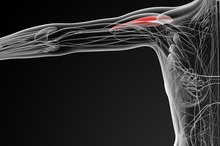The Rehabilitation of an Infraspinatus Tendon
The infraspinatus muscle is on the lower back of the scapula, or shoulder blade. It attaches to the humerus, the long bone in the upper arm, near the shoulder joint. When reaching out to the side and behind, this muscle contracts to complete this motion. It is also active with the remaining rotator cuff muscles to provide stability to the shoulder joint, such as when raising the arm overhead.
Injury
When this muscle is injured, it can be painful to reach to the side, behind, and overhead. If the injury is severe, any shoulder movement may be painful. The details of the rehabilitation process after an injury depend on the degree of injury. You should consult a musculoskeletal professional, such as a physical therapist or orthopedic doctor, prior to starting any rehabilitation.
- When this muscle is injured, it can be painful to reach to the side, behind, and overhead.
Rehab: Stage 1
Rehab Exercises for Torn Deltoids
Learn More
If the injury is severe, it is standard to begin with gentle stretching. One stretch that you might perform would be holding the injured arm at the wrist and gently pulling the injured arm across the body. Hold your stretches to tolerance, typically 10 to 30 seconds, for three to five repetitions. Once stretches are painless and do not cause soreness later in the day, you can progress to assisted movement.
- If the injury is severe, it is standard to begin with gentle stretching.
- Once stretches are painless and do not cause soreness later in the day, you can progress to assisted movement.
Rehab: Stage 2
One assisted movement that is initiated after a severe infraspinatus injury involves moving the arm on a table. Sit next to the table with the injured arm near the table. Assist the injured arm onto the table if needed. Slowly glide the arm out to the side as if reaching for something. Slowly glide the arm to the starting position. Repeat this motion five to 20 times, depending on tolerance. Variations of this exercise include gliding the arm forward and gliding side to side. Once these movements are painless and do not cause soreness later in the day, the progression to active movement will be made.
- One assisted movement that is initiated after a severe infraspinatus injury involves moving the arm on a table.
Rehab: Stage 3
Stretches for a Clicking Hip
Learn More
Active movement for the infraspinatus involves lifting the arm in front, to the side, and behind. One movement that will target the infraspinatus is to lie on your side with the injured shoulder up and the elbow bent 90 degrees. Keeping the elbow touching the body, slowly raise the hand into the air. These movements should only be performed in the portion of movement that is painless. Typically, these motions are performed for five to 20 repetitions, depending on tolerance. Once these motions are painless and do not cause soreness later in the day, a light weight may be added for resistance. This weight can be progressively increased as the movements become easier.
- Active movement for the infraspinatus involves lifting the arm in front, to the side, and behind.
- Once these motions are painless and do not cause soreness later in the day, a light weight may be added for resistance.
Related Articles
References
- "Wheeless' Textbook of Orthopaedics"; Infraspinatus; Clifford R. Wheeless, III, MD
- Family Doctor.org; Shoulder Pain; December 2010
- Delgado-gil JA, Prado-robles E, Rodrigues-de-souza DP, Cleland JA, Fernández-de-las-peñas C, Alburquerque-sendín F. Effects of mobilization with movement on pain and range of motion in patients with unilateral shoulder impingement syndrome: a randomized controlled trial. J Manipulative Physiol Ther. 2015;38(4):245-52. doi:10.1016/j.jmpt.2014.12.008
Writer Bio
Frank Bates is a licensed physical therapist who has helped patients meet their goals for over eight years. He began writing professionally in 2011. He holds a Bachelor of Arts in psychology and a Master of Physical Therapy from Marquette University and a Doctor of Physical Therapy from Chatham University.









